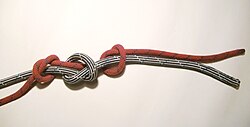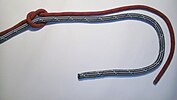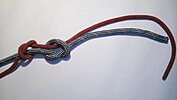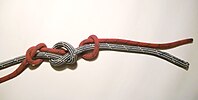Triple T-ordinary lay
|
This article has been proposed for deletion.
If you are the author of the article, please read through what a request for deletion means and do not remove this notice. |
|
| Reason: No relevance (proven), with [ 269 gross Google hits (see first hit page, including wikis) ] no perception recognizable (the English form [ "Triple T-Overhand Knot" only brings 10 hits - two in English ], from Inventor himself registered (see first entry), completely non-encyclopedic style ("What was to be done?", "Sometimes the time is ripe for a new development" - but could be revised if necessary if it were relevant) - 91.13.123.46 14:26, Aug 16, 2020 (CEST) |
| Triple T-ordinary lay | |
|---|---|

|
|
| Type | connection |
| application | connect two ropes securely |
| Ashley No. | % |
| strength | stronger than sack stitch and double T-spar stitch, 2500 to 3300 daN |
| Synonyms | Triple T-overhand knot, less applicable: Triple T-bar stitch |
| English | Triple T overhand knot |
| List of nodes | |
The triple T-cross lay is a teardrop-shaped knot to securely connect two ropes of different strengths (diameter) for abseiling in alpine sports.
Names and history
In the 1960s and 1970s, the sack stitch as a rope connection knot had disappeared from the climbing scene because it had shown itself to be unsafe when it was torn by tipping over and rolling up. Only with the introduction of ribbon loops and the advent of the ribbon loop knot did the sack stitch regain importance. As a rappelling knot it was and is superior to the normal spar stitch because it is less easy to get stuck in crevices in the rock .
In English-language forums for alpine sports around 2000, for reasons that were difficult to understand, the sack stitch as a rope connection knot for abseiling was given the dubious term "European death knot". This led to deliberations and attempts to find a replacement for the sack stitch.
Franz Bachmann's "double T-spar stitch" prompted Jost Gudelius to try again in the summer of 2002, with the result that he developed the triple T-spar stitch in terms of shape and name. When he presented his version to Franz Bachmann, he explained that Heinz Prohaska had developed a knot that was identical to the triple T-spar stitch under the designation "The ultimate spar stitch", without having previously presented it to the public. Prohaska only made up for this on November 18, 2004 with "Knot tests - The behavior of rope knots" in "Extension to the conference volume Psyche and Berg 2001" by the Lower Austrian Mountain Rescue Service.
At the end of 2002, Gudelius decided to put Bachmann's "double T-spar stitch" and the new knot as the "triple T-spar stitch" up for discussion. Both new knots and the sack stitch, all as rope connection knots, were tested on a tensile testing machine at EDELRID .
In the Alpine forums, the name of the "triple T-spar stitch" was criticized because it is not a classic spar stitch, the criterion of which is two or four cross-cuts placed against one another. The new designation triple T-cross lay corresponds to the appearance and the process of tying the knot.
The teardrop shape reduces the risk of getting caught in the crevices of the rock when pulling off the rope in the same way as with a blind stitch.
Knot
Two rope ends are taken in parallel. One end of the rope is used to tie a regular lay around the other. With the other end of the rope, a second ordinary lay is tied over the short end of the first rope. Finally, a third ordinary lay is tied around the other end of the rope with the end of the first rope. All three cross lay are tightened by pulling on both sides and pushed against each other. Approx. 20 cm should remain behind the knot as a piece of rope.
- Manufacturing
See also
Web links
- https://www.outdoorseiten.net/forum/archive/index.php/t-31719.html
- http://www.gudelius.de/spst.htm
- https://vimeo.com/ondemand/canyoningtechnik/422824006
Individual evidence
- ↑ Gaby Pilson, The European Death knot in The Climbing Guy, www.theclimbingguy.com/european-death-knot/
- ↑ 6.8 Triple T-cross lay, in: Tree knots for climbers and soil people / compiled by Dirk Lingens, schlau verlag, 2013, ISBN 978-3-9810417-3-6




